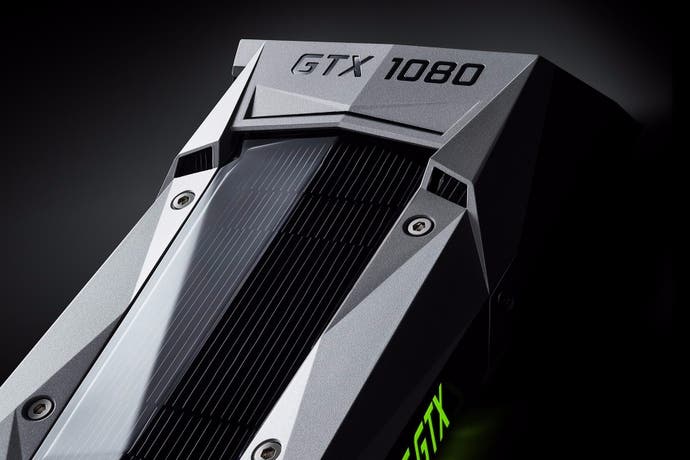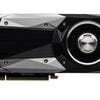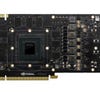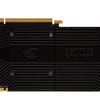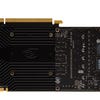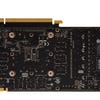Nvidia GeForce GTX 1080 review
Titan fall.
The headlines are clear enough. Requiring a mere 180W, and using just a single eight-pin PCI Express power input, the GeForce GTX 1080 offers a 25 to 30 per cent increase in overall performance compared to Titan X, combined with a 28 per cent reduction in TDP. It is the fastest graphics card on the market by a significant margin, and our testing essentially confirms Nvidia's chucklesome claims of "irresponsible levels of performance".
The GTX 1080 achieves its remarkable performance through a combination of factors: Nvidia's engineers have handed in another exemplary optimisation drive, allowing for clock-speeds over 30 per cent faster than the 900 series. This works in combination with the drop to the 16nm FinFET chip process, meaning that the same slice of silicon hosts a 2x increase in transistor density compared to the 28nm technology utilised on previous GPUs from 2011 onwards.
Thinking about upgrading your gaming PC? Take a look at our recommendations for the best graphics cards on the market. Pairing your graphics card with one of the best gaming monitors is also important, so check out our latest picks!
There are some useful new hardware enhancements too. On the media side, Nvidia's already impressive 4K and next-gen codec support gets a boost with support for 12-bit/10-bit HEVC decode plus 10-bit encode, on top of new security protocols added for top-tier media streaming. On top of that, the Polymorph engine gets a 4.0 upgrade, allowing for new functionality called simultaneous multi-projection.
Offering perspective correction on surround multi-monitor set-ups, the technology also offers stereo 3D rendering for free, plus huge performance boosts on VR applications. Up to 16 projections can be carried out in parallel, and the functionality offers up a wealth of potential. For example, a VR title could project out an additional flat 2D screen to send out for streaming. Or multi-projections of different resolutions could be composited into a single-feed, offering tangible performance boosts.
At an architectural level, there are some key advances over Maxwell - particularly in terms of asynchronous compute - and once again the firm has configured its CUDA core arrays for increased efficiency. However, it's the sheer raw speed of the Pascal architecture that is so impressive. Overclocked Maxwell processors could typically hit 1400-1500MHz before losing stability. We've seen the GTX 1080 boost to 1866MHz and it can overclock to 2.1GHz and beyond.
Faster GPUs typically require higher memory bandwidth, and with HBM limited to 4GB stacks and HBM2 off the table right now for a consumer GPU launch, Nvidia has opted for Micron's new 10gbps GDDR5X, a welcome boost from the 7gbps offered by the GDDR5 modules attached to GTX 980. It's the final flourish on an accomplished hardware design, though as you may expect, the surrounding chassis only sees limited changes.
The Founder's Edition GTX 1080 reviewed here is essentially the reference design, only Nvidia doesn't want to call it the reference design any more, and wants to charge a $100 premium for its admittedly impressive thermal solution - a premium that scales up still further with EU pricing. Nvidia says that it wants the Founders Edition to remain available across the lifespan of the card and says that it sold previous references models at a loss, until partner cards took over. The pricing strategy is a bit of an issue - this is a reference card in all but name, but the performance is good, delivering a whisper-quiet 33dBa under load with temperatures under 70 degrees.
Cosmetically, there's a new aluminium shroud, but the port arrangement remains the same with dual DVIs, three DisplayPorts and HDMI 2.0. The protective backing plate from GTX 980 returns though, and the removable portion is increased in size this time, specifically to aid thermals when two cards are grouped together for SLI purposes.
So can the Founders Edition justify its price-point? Well, Nvidia's reference cards have always been of a really high quality, with the blower set-up the optimal solution for small form-factor PCs and SLI set-ups. Overall temperatures may be higher than third party cards, but crucially, the heat is pumped out of the rear of the case as opposed to dissipating within the chassis. Nvidia also points out its solution is one of the thinnest on the market. However, adding a $100 price-premium for a design it didn't previously charge extra for is bound to rankle, particularly as this special edition isn't really that special. It's the same GP104-400 chip as everyone else - it isn't any more highly binned - and there is no factory overclock. It really is a reference card. Cheaper cards will be available, so it may well be preferable to check those out and see how good they are.
Of course, the success of GTX 1080 will all come down to its performance. In putting together this review, we decided that a revamp of our existing test system and benchmarks was required. Our older Core i7 4790K build is replaced with a brand new Core i7 6700K system, featuring 16GB of 3000MHz Corsair Vengeance LPX DDR4 mounted on an MSI Z170A Gaming M7 motherboard. All games were run from an entry-level OCZ Trion 150 SSD.
And as for the titles chosen for benchmarking, we put together an array of titles designed to make life extremely uncomfortable for our test subjects. This year we've noted that the Radeon R9 390 has scored some decent wins over the GTX 970, so titles like Far Cry Primal and Hitman make the grade. Ashes of the Singularity has caused immense challenges for Nvidia hardware, so that's added to the mix too. But to level things up, top-tier games that cause issues for AMD are also added into the mix, including the visually spectacular Project Cars and the destroyer of VRAM, Assassin's Creed Unity.
We also need to acknowledge the transition from DirectX 11 to DX12 in our testing, so we have three titles tested on both APIs - the aforementioned Ashes of the Singularity, Rise of the Tomb Raider and Hitman. Does AMD really have an advantage with DirectX 12, and if so, could it actually see the older Fury X offer any kind of challenge to the new GTX 1080? We were intent on finding out. And finally, while we've attempted to make life as uncomfortable as possible for our tested GPUs, we believe the tests need to be on a level playing field, so Nvidia-specific technologies like the performance-killing HairWorks in The Witcher 3 are disabled. We also want to test computational power over bandwidth, so we tend to turn off MSAA. Now, let's begin with 1080p testing.
| 1920x1080 (1080p) | GTX 1080 | Titan X | GTX 980 | GTX 780 Ti | R9 Fury X | R9 390X |
|---|---|---|---|---|---|---|
| Assassin's Creed Unity, Ultra High, FXAA | 99.0 | 75.0 | 58.7 | 48.6 | 64.6 | 56.4 |
| Ashes of the Singularity, Extreme, 0x MSAA, DX11 | 76.5 | 62.5 | 50.6 | 43.2 | 58.3 | 47.1 |
| Ashes of the Singularity, Extreme, 0x MSAA, DX12 | 77.8 | 59.8 | 48.3 | 41.3 | 69.9 | 56.5 |
| The Division, Ultra, SMAA | 94.0 | 73.9 | 57.8 | 46.6 | 66.7 | 55.2 |
| Far Cry Primal, Ultra, SMAA | 109.3 | 81.8 | 63.3 | 56.1 | 75.1 | 68.3 |
| Hitman, Ultra, SMAA, DX11 | 106.0 | 84.0 | 54.7 | 47.9 | 89.6 | 75.1 |
| Rise of the Tomb Raider, Ultra, SMAA, DX11 | 134.7 | 101.9 | 81.4 | 67.2 | 78.7 | 70.5 |
| The Witcher 3, Ultra, Post AA, No HairWorks | 111.8 | 86.8 | 65.6 | 54.0 | 70.3 | 56.5 |
| Project Cars, Ultra, SMAA | 79.9 | 63.8 | 48.3 | 40.1 | 40.7 | 34.7 |
For our chosen hardware, we've gone with three prior generations of top-tier Nvidia hardware - Titan X and GTX 780 Ti represent the fully unlocked 'big chip' versions of the older Maxwell and Kepler architectures, while GTX 980 is effectively the last-gen version of the card we're reviewing today, based on a smaller processor design. On the AMD side, we have R9 Fury X - its Titan X challenger, along with R9 390X, effectively the red team's answer to GTX 980.
GTX 1080 offers a 29.6 per cent average increase in performance across all of our tests compared to Titan X, and a 65 per cent boost to frame-rates compared to GTX 980. That increases enormously to 103 per cent with GTX 780 Ti, but there is the sense that the 3GB of VRAM on the older card causes issues, especially with Io Interactive's Hitman, which seems to devour memory in its maxed out configuration.
But it's the comparisons with AMD that prove fascinating. Nvidia hardware scales fairly nice across generations even at lower resolutions. However, the R9 Fury X only really shows its true capabilities at much higher pixel counts, and performance is depressed at 1080p. Boosts against R9 390X are fairly limited, and the end result is that GTX 1080 is a massive 49.8 per cent faster - dropping to 45 per cent if you want to factor out Project Cars, a title that has long bedevilled AMD cards. However, also surprising here is just how far behind Rise of the Tomb Raider is here, offering little improvement over the R9 390X. On the flip-side, Hitman is clearly a real contender on AMD hardware - GTX 1080 is the quicker card, but only 18 per cent faster.
To cut a long story short, at 1080p, the GTX 1080 is essentially untouchable. There's an argument that says that top-tier GPU hardware is under-utilised at full HD resolution. That's definitely the case with R9 Fury X and something we noted when we tested Titan X on its launch driver, but the data here suggests that Nvidia has optimised well, and GTX 1080 is viable for high refresh full HD displays.
| 2560x1440 (1440p) | GTX 1080 | Titan X | GTX 980 | GTX 780 Ti | R9 Fury X | R9 390X |
|---|---|---|---|---|---|---|
| Assassin's Creed Unity, Ultra High, FXAA | 64.0 | 48.8 | 38.1 | 29.9 | 41.4 | 38.4 |
| Ashes of the Singularity, Extreme, 0x MSAA, DX11 | 68.6 | 53.7 | 44.6 | 38.5 | 54.0 | 44.1 |
| The Division, Ultra, SMAA | 68.4 | 54.2 | 41.4 | 33.2 | 51.0 | 42.4 |
| Far Cry Primal, Ultra, SMAA | 77.0 | 57.1 | 45.3 | 38.8 | 57.6 | 50.9 |
| Hitman, Ultra, SMAA, DX11 | 82.2 | 61.1 | 45.6 | 34.6 | 70.0 | 58.2 |
| Rise of the Tomb Raider, Ultra, SMAA, DX11 | 88.7 | 69.3 | 54.8 | 44.9 | 58.2 | 49.7 |
| The Witcher 3, Ultra, Post AA, No HairWorks | 79.2 | 62.1 | 46.6 | 39.6 | 54.7 | 43.6 |
| Project Cars, Ultra, SMAA | 66.7 | 47.2 | 39.5 | 30.8 | 32.1 | 27.2 |
Titan X and GTX 980 Ti really found their feet at 1440p resolution - the sweet spot between pixel-count, quality settings and performance. The new GTX 1080 maintains a very similar performance differential with its predecessors here, handing in a 29.5 per cent boost to frame-rates overall compared to Titan X, rising to 68.8 per cent with GTX 980. Lowest recorded frame-rates get similar increases too - the takeaway here being that on traditional 60Hz displays, the new card will offer more stable performance overall on higher quality settings.
There are some impressive gains here under DX11 - for example, Hitman and Far Cry Primal are both around 35 per cent faster than Titan X. And even titles with the lowest increases - Ashes of the Singularity and The Witcher 3 - are still over 27 per cent faster. You can expect those percentages to increase slightly up against GTX 980 Ti. We're going to update a little later with GTX 980 Ti benchmarks - time was limited here and our FCAT workflow is time-intensive, so we opted to bench against the fully unlocked GM200 Titan X instead, but performance should be roughly ballpark.
As expected, Fury X starts to up its game when given a higher resolution to work with. GTX 1080's 45 per cent lead (49.8 per cent factoring in Project Cars) drops to 42.5 per cent with the Slightly Mad racer included, or just 35.9 per cent with it omitted from the average (note: these averages include our DX12 tests too - more on those below). Io Interactive's Hitman is just 17 per cent faster on GTX 1080, suggesting that some titles that really benefit AMD architecture can make up some of the shortfall compared to Nvidia's new hardware.
The end result is clear enough - GTX 1080 is the undisputed king of the hill at 1440p too. For those interested, adding an additional 77 per cent of resolution compared to full HD sees a 26 per cent drop in frame-rates overall - an equitable trade and once again, we feel that this resolution, along with the 3840x1440 ultra-wide variant offer the sweet-spot in terms of pixel density vs performance.
| 3840x2160 (4K) | GTX 1080 | Titan X | GTX 980 | GTX 780 Ti | R9 Fury X | R9 390X |
|---|---|---|---|---|---|---|
| Assassin's Creed Unity, Ultra High, FXAA | 32.5 | 25.6 | 18.3 | 13.9 | 22.6 | 20.2 |
| Ashes of the Singularity, Extreme, 0x MSAA, DX11 | 53.7 | 42.1 | 34.2 | 29.5 | 43.6 | 35.4 |
| The Division, Ultra, SMAA | 37.3 | 30.7 | 23.6 | 17.8 | 31.1 | 25.2 |
| Far Cry Primal, Ultra, SMAA | 42.4 | 33.5 | 25.1 | 21.2 | 34.5 | 29.7 |
| Hitman, Ultra, SMAA, DX11 | 47.7 | 35.4 | 26.7 | 20.6 | 43.1 | 36.3 |
| Rise of the Tomb Raider, Ultra, SMAA, DX11 | 48.0 | 37.5 | 28.6 | 23.5 | 32.7 | 27.4 |
| The Witcher 3, Ultra, Post AA, No HairWorks | 43.7 | 34.0 | 25.6 | 25.0 | 32.8 | 25.9 |
| Project Cars, Ultra, SMAA | 38.5 | 29.8 | 22.5 | 18.5 | 20.9 | 17.8 |
Moving onto 4K resolution and there is no quarter given to our GPUs here. We use the same punishing quality presets as we do at the lower resolutions, presenting a double-whammy of challenges for our test hardware: not only are we witnessing a 4x increase in resolution compared to 1080p, VRAM requirements also go through the roof on certain titles.
The data for GTX 1080 here is compelling. Overall, we see a 28.8 per cent increase in performance over Titan X, rising to 69.7 per cent stacked up against GTX 980. However, the real takeaway here is that we're getting some pretty impressive 4K results here from GTX 1080 even with these ramped up quality presets. More testing with balanced settings would be needed, but there's enough evidence here to suggest that GTX 1080 may well be the first single-GPU card capable of carrying off 4K gameplay with decent quality settings on demanding games. Of the titles tested here, only AC Unity, The Division and Project Cars post minimum frame-rates under 30fps in our tests - a promising sign.
But it's the comparison with Fury X that is perhaps most fascinating. Project Cars is still a write-off and Rise of the Tomb Raider is still too slow, but three titles stand out in offering relatively strong performance. Hitman on DX11 is only 10 per cent faster on GTX 1080, the Division is only 20 per cent faster while Far Cry Primal only sees a 22.3 per cent boost when using the latest Nvidia tech. You'll note that in our revised, more modern GPU benchmark suite, Fury X is actually posting a few wins over Titan X - specifically with Ashes of the Singularity, The Division, Far Cry Primal and Hitman.
But for now, 4K performance with GTX 1080 is looking good. For the record, quadrupling pixel count compared to 1080p sees a 56.6 per cent drop in performance. And here's another interesting stat. Averaging out all frame-rates, the GTX 1080 running at 4K is only 18 per cent slower than a GTX 780 Ti running the same benchmarks at 1080p. Impressive stuff overall, but just how well does GTX 1080 run with the latest DirectX 12 titles?
| DirectX 12 1080p | GTX 1080 | Titan X | GTX 980 | GTX 780 Ti | R9 Fury X | R9 390X |
|---|---|---|---|---|---|---|
| Ashes of the Singularity, Extreme, 0x MSAA | 77.8 | 59.8 | 48.3 | 41.3 | 69.9 | 56.5 |
| Hitman, Ultra, SMAA | 108.0 | 79.3 | 61.9 | 44.9 | 89.3 | 79.8 |
| Rise of the Tomb Raider, Ultra, SMAA | 130.5 | 100.1 | 80.4 | 66.1 | 65.6 | 64.7 |
| DirectX 12 2560x1440 (1440p) | GTX 1080 | Titan X | GTX 980 | GTX 780 Ti | R9 Fury X | R9 390X |
|---|---|---|---|---|---|---|
| Ashes of the Singularity, Extreme, 0x MSAA, 1440p | 68.9 | 51.6 | 41.7 | 36.0 | 63.4 | 51.8 |
| Hitman, Ultra, SMAA, 1440p | 81.6 | 59.0 | 45.9 | 33.8 | 70.9 | 62.1 |
| Rise of the Tomb Raider, Ultra, SMAA, 1440p | 86.8 | 67.4 | 52.8 | 43.4 | 50.6 | 47.5 |
| DirectX 12: 3840x2160 (4K) | GTX 1080 | Titan X | GTX 980 | GTX 780 Ti | R9 Fury X | R9 390X |
|---|---|---|---|---|---|---|
| Ashes of the Singularity, Extreme, 0x MSAA, 4K | 53.3 | 40.9 | 32.4 | 26.7 | 49.0 | 40.2 |
| Hitman, Ultra, SMAA, 4K | 47.0 | 34.5 | 26.1 | Crash | 44.2 | 37.1 |
| Rise of the Tomb Raider, Ultra, SMAA, DX12 | 45.8 | 35.9 | 27.5 | 22.9 | 29.6 | 25.3 |
Testing on DX12 has been challenging for a number of reasons. We prefer to use FCAT for performance testing, the reason being that nothing beats performance metrics based on analysis of the actual frames delivered to your screen. Until recently, FCAT wasn't possible on DX12 - but that changes now thanks to new software from Nvidia. Secondly, the lion's share of DX12 titles have appeared on the Windows Store where the limited UWP platform's hitherto locked v-sync effectively kills off granular benchmarking.
That's changed now, so hopefully we can revisit that in the future, but in the meantime, we have three DX12 titles that we can compare - and the results are intriguing. For example, Hitman is a strong AMD title under DX11, running around 10 per cent slower on Fury X compared to GTX 1080. Under DX12, the performance bump is fairly minimal in terms of the experience, but the percentage shifts even closer - Fury X offers 94 per cent of GTX 1080's tally. However, at lower resolutions, Nvidia's lead does increase significantly.
The thorn in Nvidia's side - Ashes of the Singularity - also serves up some interesting results. At 1440p and 4K resolution, the Fury X offers up 92 per cent of GTX 1080's performance level, dropping back to 90 per cent at 1080p. However, the notion that DirectX 12 is an all-out win for AMD is far from the complete picture. Rise of the Tomb Raider is still massively faster on Nvidia hardware, and in fact, with our Core i7 system, GPUs from all vendors actually post a regression in performance compared to DirectX 11.
We intend to carry out more testing on DX12 now we have the tools, and once more titles on the Windows Store receive the ability to unlock frame-rates, but for now, there's the sense that we don't really have enough data to get a full picture of what's going on. What's clear is that GTX 1080's DX12 credentials are improved over the last-gen Maxwell, though not dramatically so based on the meagre amount of software can analyse right now. You'll note that the frame-rate regression seen in prior Nvidia cards on Ashes of the Singularity is gone - though there is no actual increase in performance as such.

| GTX 1080 | Titan X | GTX 980 | GTX 780 Ti | R9 Fury X | R9 390X | |
|---|---|---|---|---|---|---|
| Peak System Power Draw | 303W | 361W | 296W | 337W | 385W | 453W |
Finally, let's take a look at power consumption and offer some initial thoughts on overclocking. You'll see from the table above that GTX 1080 is rivalled only by GTX 980 in terms of its efficiency, tested here using our 'burn in' scene from Crysis 3 - where power consumption is pushed to some crazily high levels. The move to 16nm FinFET isn't just delivering some big boosts to performance, it is matched by a significant reduction in power draw.
All of which may suggest the potential for some impressive overclocking - something that has been promised by Nvidia, but unfortunately something we didn't have time to test in any depth. The new Pascal architecture has new overclocking features, requiring new software - which arrived two days ago in a semi-broken state. What we can tell you is that GPU Boost 3.0 offers users the ability to go beyond the basic core and memory clock offsets: instead, bespoke software can scan the entire voltage ramp, adjusting boost clocks at each step. Nvidia's pre-release build of EVGA's PrecisionX tool uses Furmark to find optimal boost frequencies, and you can adjust the overclock from there. We're looking forward to testing it once the overclocking software is a little less crash-happy.
However, the build we did have worked for using the older style of frequency offset overclocking. Here, we could boost core clocks beyond 2GHz, though the card got a lot hotter - up from 65 degrees at stock to around 85 degrees, requiring much more aggressive fan speeds to reduce temperatures. We'll be interested to see just how overclockable GTX 1080 turns out to be - boost clocks at stock speeds could hit 1866MHz, which is extremely fast already. It may well be the cast that the hugely impressive percentage boosts to performance we saw with Maxwell may well be somewhat lower on Pascal, assuming something like a 2.1GHz top-end. Right now it's too early to tell - but what we can say for sure is that GDDR5X throughput is highly impressive, and we had no problem running the modules at 11gbps, up from the stock 10gbps.
Nvidia GeForce GTX 1080 - the Digital Foundry verdict
The first FinFET-based GPU is a resounding success. The last-gen Titan X offered up a 601mm2 slice of silicon offering 6.2TFLOPs of power. The GTX 1080's GP104 processor is around half the size, offering 30 per cent more gaming performance and hands in a 16 per cent drop in power consumption under peak load, based on our testing. And what's impressive here is that the increase in performance scales fairly well across all resolutions, dropping back just a little at 4K, where memory bandwidth may well be a slightly limiting factor.
From our perspective, the big takeaway is this: Titan X and its cheaper GTX 980 Ti counterpart are still monstrously fast gaming GPUs. They're the cards we've gone to for testing when we need what seems like a bottomless pit of graphics power. If the upcoming GTX 1070 is priced correctly and offers equivalent performance, we're in for a real treat. But the GTX 1080 isn't just a little faster - it's a lot faster. And assuming its simultaneous multi-projection technology is indeed integrated into upcoming VR titles, the performance increase there could very well match the 2x Titan X claims that Nvidia made at its recent press event.
Questions do remain - specifically on just how much overclocking headroom is available, and how the new GPU Boost 3.0 technologies will actually help performance - but the bottom line is that even at stock frequencies, Nvidia has indeed delivered exceptional performance. GTX 1070 may well turn out to be the genuine gamechanger for the market - just like the GTX 970 before it - but Nvidia's new flagship is unquestionably the best graphics card money can buy right now, but that extreme performance doesn't come cheap.
